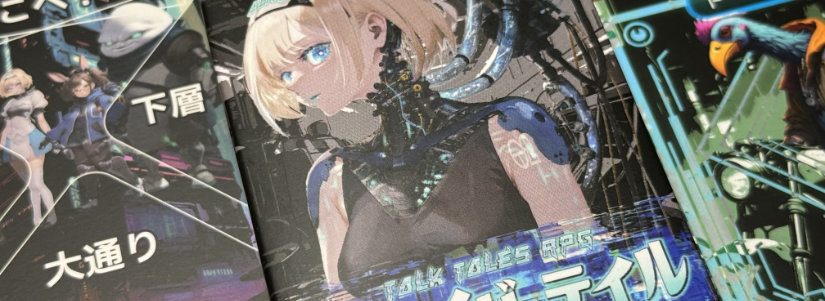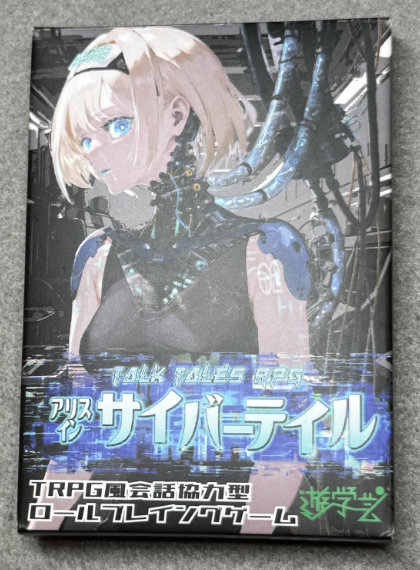
Alice in Cybertales (アリス イン サイバーテイル) is a svelte thirty two card TRPG-like cooperative conversation game. It puts the TRPG element of interacting with NPCs its core mechanic. Set in a Cyberpunk Alice and Wonderland inspired world where the PCs are searching for a rabbit. As part of this search, the players attempt to gather information from the city’s inhabitants.
It’s supports two to five people, including one as the GM, and estimated game time is under thirty minutes, making for a snappy game.
Made by Yuugakugei (遊学芸), a prolific group whose works include Summon Skate, it’s visuals and production are top notch.
While similar to NoviNovi TRPG games in that it’s card based role playing game, its focus differs. Where NoviNovi is follows a more common formula of characters with attributes and abilities, Alice in Cybertale focuses solely on character discussion– that of the PCs asking NPCs where the elusive rabbit has gone.
The Physical
The thirty two cards have a nice finish and come in a small playing card box. The rules are available by scanning a QR code on the back of the box, but there are also several cards containing the rules.
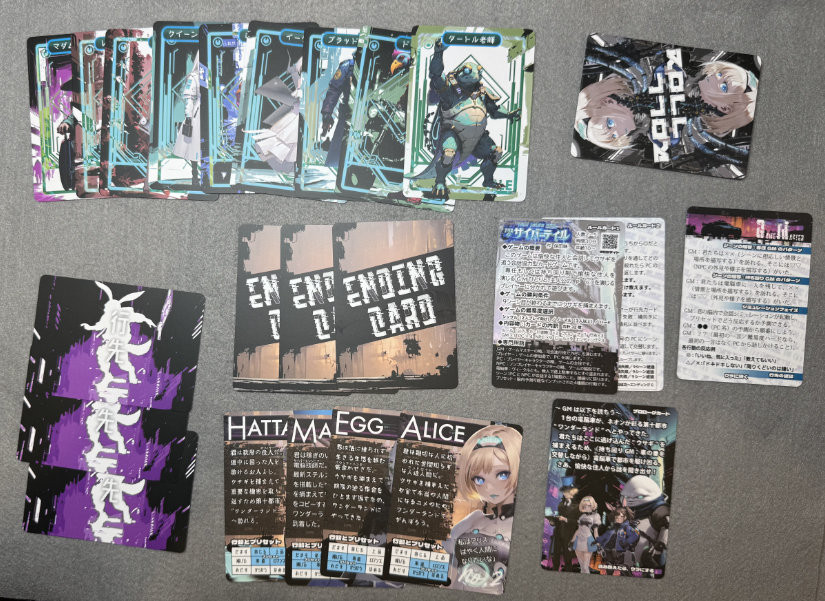
- 2 Rules Cards
- 1 Prologue Card
- 1 GM Card
- 4 PC Cards
- 3 Ending Cards
- 4 Whereabouts Cards
- 9 Role Cards
- 9 NPC Cards, which are double sided with different characters
Rules
The game can be played with two to five players. With only two players, the GM role rotates. With three or more players, there is a dedicated GM. After selecting the GM, players choose a character card. Each character has a short background and artwork, with the only mechanical differencing between them being their “presets”, which we’ll get to in the gameplay section. The game is finishes within nine scenes.
Setup
Cards are laid out with a deck of NPC Cards, either side up, and deck of Role Cards, face down, next to each other. Beneath the NPC deck is the Prologue card, which indicates three directions the Rabbit could have taken: Upper Level, Lower Level, or Main Street. The Whereabouts Cards are shuffled and one card is randomly placed at each location.
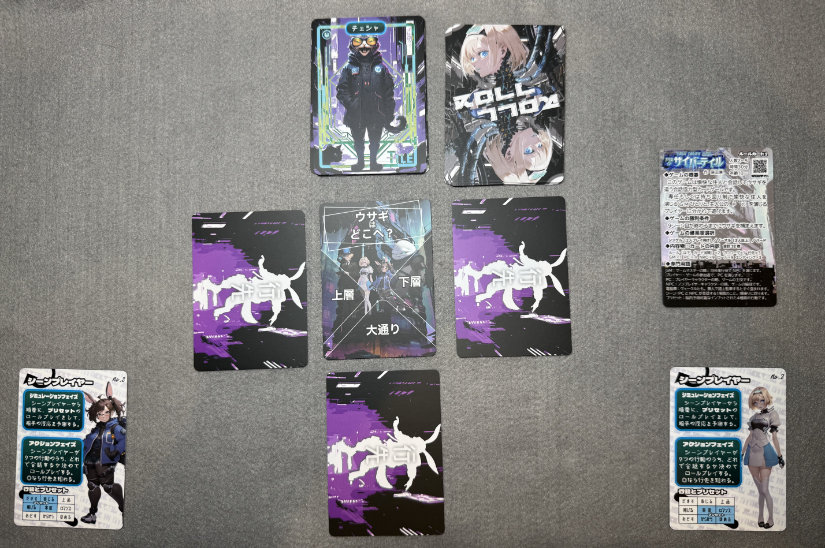
Gameplay
Divided into scenes, each scene consists of two phases: Simulation and Action. The Simulation phase allows PCs to try out their Preset actions to see how the NPC responds, with the Action phase the choices determine failure or success.
Flipping over the NPC card and drawing a Role card, the GM combines sets the scene, location, and type of NPC based on the NPC artwork and the Role card details.
Role cards specify how the NPC reacts to nine different actions players can take:
- Deceive
- Command
- Elegance
- Flattery
- Honesty
- Romance
- Threats
- Teasing
- Compliments
Each action is rated by how favorably (or not) the NPC responds. ◎ indicates a favorable reaction, △ a mixed reaction, and × a negative reaction. During a simulation, if you choose an action the NPC is favorable, they’ll tell you the correct direction. Mixed or negative reactions, and they’ll give you a hint. During the action, choose a favorable action and the NPC will tell you the correct direction. A mixed reaction they’ll tell you one of the failure directions, and a negative reaction nets you nothing.
Simulation Phase
The Simulation phase starts with “the scene player” having the first simulated reaction with the NPC. Being a virtual simulation, the PC is limited to their Preset Actions in what they can do. Once they choose an action, they role play asking the NPC using the selected methodology (such as threaten, deceive, command). The conversation continues until the GM guesses the player’s selected action, checking how the NPC responds to the action on the Role Card. Going clockwise, players take turns until all have had a simulation.
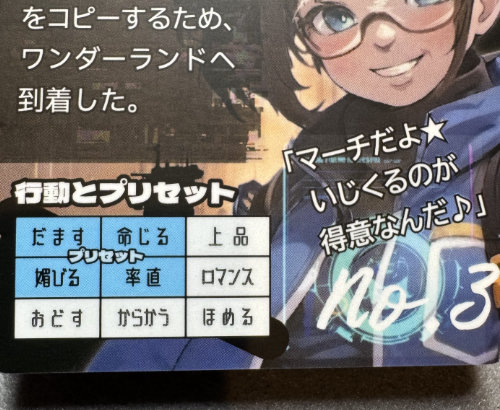
Action Phase
After all players have role played a simulation scene, the GM checks which direction the rabbit went. The scene player then choose an action (not limited to their presets) they think will have a favorable outcome and role play the conversation. Once the GM guesses the action, they let the PC know the results of it. Based on the information gathered thus far, the scene player flips over a Whereabouts card and checks the results.
Results
A single success or failure isn’t enough to win or lose the game. A number of successes based on the difficulty (4, 5, or 6 times) must be completed in order to win. If the ninth scene ends without having succeeded, the game is over and the rabbit gets away.
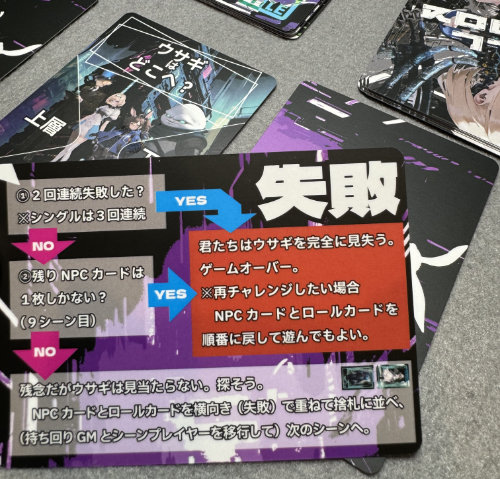
Details
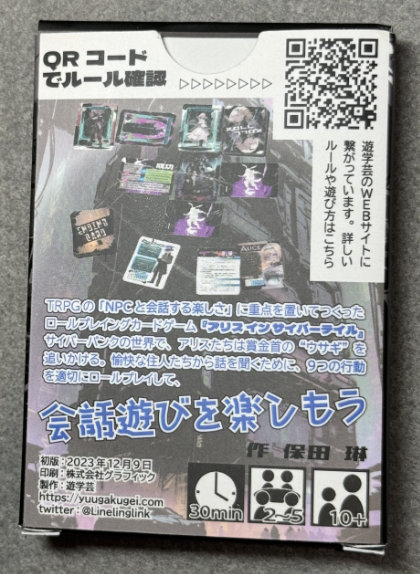 Released 2023 by Yuugakugei, game design and illustration was all done by Lin Yasuda (保田琳). Official Site
Released 2023 by Yuugakugei, game design and illustration was all done by Lin Yasuda (保田琳). Official Site
The physical version I picked up at 2023 Tokyo Game Market for ¥1,000 seems to be out of print, but there is a Cocofolia assets version available on Booth.

